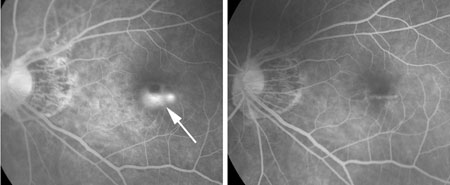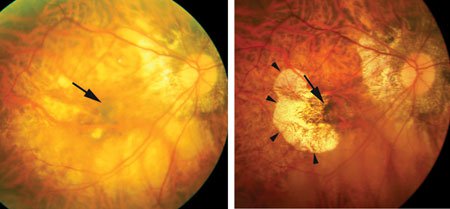Study finds intravitreal antiVEGF effective for nonsubfoveal myopic CNV
Intravitreal bevacizumab was shown to be a good treatment for choroidal neovascularization in patients with pathologic myopia, according to a study.
“The three major causes of vision impairment in highly myopic eyes are myopic CNV, myopic traction maculopathy and myopic optic neuropathy,” study co-author Kyoko Ohno-Matsui, MD, of the high myopia clinic at Tokyo Medical and Dental University, told OSN Retina.
Of 75 eyes of 69 consecutive Japanese patients with myopic choroidal neovascularization treated with Avastin (bevacizumab, Genentech), 26 eyes of 26 patients had subfoveal CNV and 49 eyes of 47 patients had non-subfoveal CNV. Patients received a mean of 1.8 injections of bevacizumab during a mean follow-up period of 2.2 years.

Kyoko Ohno-Matsui
In eyes with subfoveal CNV, there was no significant difference in best corrected visual acuity from baseline to final follow-up. However, mean BCVA in eyes with non-subfoveal CNV improved from 20/66 to 20/40 during the same period (P < .001).
The investigators also found that the incidence of chorioretinal atrophy after 2 years was only 6.1% for non-subfoveal CNV but 80.8% for subfoveal CNV. The mean chorioretinal atrophy area for non-subfoveal CNV was 0.05 mm2, compared with 1.76 mm2 for subfoveal CNV.
The prospective study was published in Retina.
Challenges of treatment
Even though anti-VEGF therapy has been very effective against myopic CNV, not all patients are happy about receiving treatments, Ohno-Matsui said.
“We wanted to clarify in what kinds of eyes anti-VEGF therapies work well and in what kinds of eyes this treatment does not work well,” she said.
A surprise finding was that anti-VEGF therapy caused non-subfoveal CNV to disappear.
“The patient’s fundus looks like nothing happened. The CNV is completely gone,” she said.
In contrast, the subfoveal CNV shrank somewhat but did not disappear, and chorioretinal atrophy develops around the scarred subfoveal CNV in the long term, Ohno-Matsui said.

Marked shrinkage of non-subfoveal CNV due to pathologic myopia by anti-VEGF therapy. At onset (left image), the dye leakage from the CNV is seen in fluorescein angiogram. The BCVA is 0.7. At 3 months after intravitreal injection of bevacizumab (right image), the dye leakage is absent. The CNV has markedly shrunk and looks like a thin line. The BCVA has improved to 1.0.
Images: Ohno-Matsui K

Development of chorioretinal atrophy around the regressed subfoveal CNV. At onset (left image), the grayish CNV is observed (arrow). The BCVA is 0.5. At 2 years after intravitreal injection of bevacizumab (right image), the CNV (arrow) has become a pigmented scar. However, a well-defined chorioretinal atrophy has developed around the regressed CNV (arrowheads). The BCVA is 0.04.
The more successful treatment of non-subfoveal CNV may be attributable to the smaller size and activity of non-subfoveal CNV compared to subfoveal CNV, according to Ohno-Matsui.
“Usually, non-subfoveal CNV is smaller than subfoveal CNV, because large CNV tends to include the fovea. Thus, it is possible that non-subfoveal CNV responds to the treatment very well because it is less active,” she said.
Because subfoveal CNV does not disappear using anti-VEGF and because later chorioretinal atrophy develops around the scarred CNV, the challenge in developing an effective treatment for subfoveal CNV is to address both processes.
“Because anti-VEGF alone cannot wipe out subfoveal CNV, a more potent anti-angiogenesis drug should be used instead or in combination with anti-VEGF. For example, pigment epithelium-derived factor might be a good candidate,” Ohno-Matsui said.
Chorioretinal atrophy prevention
Preventing the development of chorioretinal atrophy is more difficult, according to Ohno-Matsui.
“The reason why chorioretinal atrophy later develops around subfoveal CNV is not clear; however, mechanical expansion of posterior fundus plays some role. Preventing mechanical expansion of the posterior eye segment would be one option,” Ohno-Matsui said.
Non-subfoveal CNV tends to be missed during examination because it is usually small and does not accompany wide hemorrhage.
“To achieve a complete disappearance of non-subfoveal CNV, early treatment would be better,” she said.
In order to detect very small non-subfoveal CNV in highly myopic eyes, she recommended listening carefully to patient complaints and examining the macula with a magnified lens.
“We still need to perform fluorescein angiography because myopic CNV does not accompany marked exudative changes within the retina, plus CNV itself is tiny,” she said. “Thus, sometimes it is difficult to judge the activity of CNV solely by [optical coherence tomography].”
Chorioretinal atrophy around the regressed CNV is a late complication of myopic CNV, and many ophthalmologists do not pay much attention to it because they are more concerned about the short-term outcomes, according to Ohno-Matsui.
“However, it is chorioretinal atrophy and not CNV itself that determines the long-term visual prognosis in patients with myopic CNV,” she said.
Because CNV develops at a younger age than age-related macular degeneration, the long-term prognosis is more important in myopic patients, Ohno-Matsui said. – by Bob Kronemyer
Reference:
- Hayashi K, Shimada N, Moriyama M, Hayashi W, Tokoro T, Ohno-Matsui K. Two-year outcomes of intravitreal bevacizumab for choroidal neovascularization in Japanese patients with pathologic myopia. Retina. 2012;32(4):687-695.
For more information:
- Kyoko Ohno-Matsui, MD, can be reached at the Department of Ophthalmology and Visual Science at & Vision Science, Tokyo Medical and Dental University, 1-5-45 Yushima, Bunkyo-ku, Tokyo 113, Japan; 81-358035302; email: k.ohno.oph@tmd.ac.jp.
- Disclosure: Ohno-Matsui has no relevant financial disclosures.
